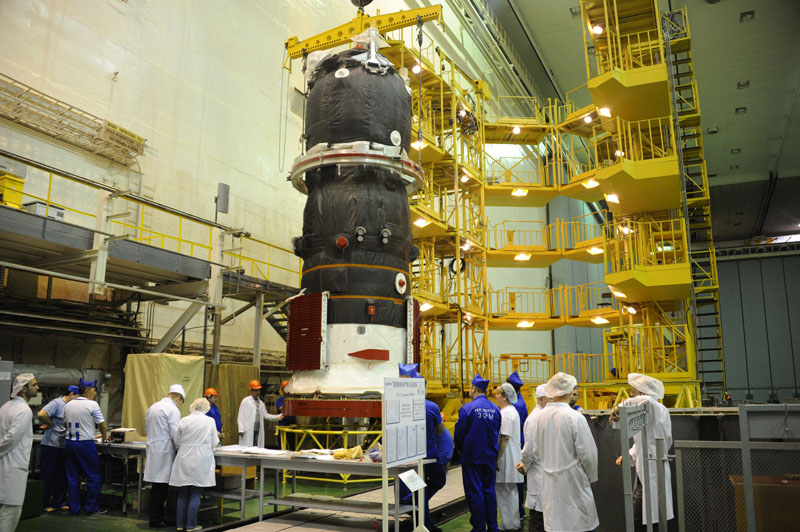Out-of-Control Russian Spacecraft Will Fall from Space Overnight Tonight


An out-of-control Russian cargo ship is headed for a destructive plunge into Earth's atmosphere overnight between Thursday and Friday (May 7-8), with satellite watchers around the world trying to pinpoint the exact time and place of the craft's fall from space.
The uncrewed Progress 59 spacecraft has been falling to Earth since just after its launch last week on April 28 on a mission to deliver nearly 3 tons of supplies to the International Space Station.
In a statement released today (May 7), the Russian space agency Roscosmos said that Progress 59 "will cease to exist" on Friday, adding that they would release updates on the time of re-entry for the spacecraft. [See photos of the doomed Progress 59 spacecraft]
"The ESA space debris team re-entry predictions now show the re-entry window has shrunk to include just the night of Thursday/Friday, 7/8 May," European Space Agency spokesman Daniel Scuka wrote in an update today. "We can exclude any time after early Friday morning. There are some first indications that the likelihood for a re-entry over North America or Europe has dropped significantly."
The problems with Progress 59 began shortly after liftoff, when the spacecraft experienced technical difficulties – perhaps due to a malfunctioning Soyuz rocket third stage. Video from a camera on Progress 59 showed the craft to be spinning, leaving Russian ground controllers unable to command the vehicle as it tumbled through space.
Since then, Russia's State Commission for manned space complex flight tests has formed a board to review the Progress supply craft mishap. The conclusions are expected to be made by May 13, according to Roscosmos.
Tracking Progress 59 in space
Veteran satellite observer Ted Molczan of Canada places the re-entry of the Progress as occurring later tonight, May 7, at about 10:03 p.m. EDT (0203 May 8 GMT) as of Thursday afternoon. The uncertainty is 1.9 hours, Molczan said, given a number of factors, including the influence of space weather and its impact on the density of Earth's atmosphere.
Breaking space news, the latest updates on rocket launches, skywatching events and more!
"It is impossible to know enough about the recent and future state of the spacecraft and the space environment to make precise predictions," Molczan told Space.com. "The challenge seems not unlike that faced by meteorologists attempting to predict the landfall of a hurricane."
The public can track the path of Progress 59 online via a satellite-tracking website like Heaven's Above or n2yo.com.
The n2yo.com has created a special webpage for Progress 59 that features multiple views of the spacecraft's path. You can also follow Progress 59's path in the map below, as shown by ny2o.com:
Progress 59: Lost in space
It is likely that some leftovers of Progress 59 will survive the fiery dive through Earth's atmosphere and reach the surface, said Holger Krag, Head of ESA's Space Debris Office at the European Space Operations Center in Darmstadt, Germany.
"With every re-entry of a large structure from space you can expect a small fraction to survive," Krag has told Space.com. But there is an extremely small probability that somebody would be injured from the fall of debris, he added. [6 Biggest Spacecraft to Fall Uncontrolled from Space]
According to the Russian aerospace company RSC Energia – which built the spacecraft – Progress 59 is carrying propellant components, compressed oxygen, additional equipment that was needed to "maintain the station in good working order," equipment for science experiments, medical supplies, personal belongings and food for the crew.
Altogether more than 5,200 lbs. (2,359 kg) of cargo is packed inside Progress 59, including 3,075 lbs. (1,395 kg) of dry cargo, 1,089 lbs. (494 kg) of propellant, 925 lbs. (420 kg) of water and 110 lbs. (50 kg) of compressed gases. The International Space Station is not in any danger of running out of supplies due to the loss of the spacecraft, NASA officials and the station's astronaut crew have said.
Progress 59 is also known in Russia as Progress M-27M, and is one of RSC Energia's Progress M-M spacecraft series, an upgraded version of the previous Progress M-series line.
According to RSC Energia representatives, Progress 59 is equipped with new devices for the motion control and navigation system and an improved onboard measurement system. All the devices are built around state-of-the-art electronic components and run the latest software. The upgrade made it possible to reduce the mass of the onboard equipment and thus enhance the capability to deliver payload to orbit.
Leonard David has been reporting on the space industry for more than five decades. He is former director of research for the National Commission on Space and is co-author of Buzz Aldrin's 2013 book "Mission to Mars – My Vision for Space Exploration" published by National Geographic with a new updated paperback version released this month. Follow us @Spacedotcom, Facebook and Google+. Original article on Space.com.

Leonard David is an award-winning space journalist who has been reporting on space activities for more than 50 years. Currently writing as Space.com's Space Insider Columnist among his other projects, Leonard has authored numerous books on space exploration, Mars missions and more, with his latest being "Moon Rush: The New Space Race" published in 2019 by National Geographic. He also wrote "Mars: Our Future on the Red Planet" released in 2016 by National Geographic. Leonard has served as a correspondent for SpaceNews, Scientific American and Aerospace America for the AIAA. He has received many awards, including the first Ordway Award for Sustained Excellence in Spaceflight History in 2015 at the AAS Wernher von Braun Memorial Symposium. You can find out Leonard's latest project at his website and on Twitter.


